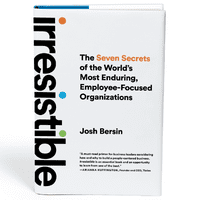Why We Are Entering A Secular Labor Shortage
There are lots of economists waiting for the labor market to “cool,” enabling unemployment to rise and inflation to slow. Yet despite these projections, unemployment remains at a 45 year low and it’s still hard to hire. Why the change? Our research clearly shows that we’ve entered a whole new economy, one that makes labor shortages a long-term trend.
What does “secular” mean? Well Webster’s Dictionary defines it as “of or relating to a long term of indefinite duration.” And that’s the labor market trend we see.
Let me cite some recent data. This week the BLS published its ten-year forecast for the US labor market. Driven by demographics and the low birth rate, the BLS projects total US employment growth will only average .3% over the coming decade. And to make it worse, labor participation rate will drop from 62.2% to 60.4%, which means about 7 million additional workers will slow down and stop working.
The reasons for this are simple: we now live in a low birth-rate country (similar to Japan, Germany, UK, China, and most other developed countries). And as our longevity goes up (thanks to wonderful medical science), many of us work less as we get older. So ultimately the math is clear: within ten years most developed countries will “peak” in their working population. (You can read the World Bank analysis to see which year will peak by country, by the way.)
Despite this labor shortage, GDP is expected to rise. The BLS believes the US GDP will continue to grow at 1.9% over the next decade, which essentially means we have two diverging lines. The GDP “per worker” simply has to accelerate its rise.
As I discuss in my speech “The Post-Pandemic Economy,” this problem should be solved by automation, AI, and all sorts of “organizational ingenuities” we pioneer in our companies. But nevertheless, hiring is getting harder. Our newest benchmark study on time-to-hire clearly shows that almost every job role in every industry is getting harder to fill. And that means companies have to spend more effort on internal development, talent mobility, and career pathways for existing staff. (Much our new Systemic HR research shows you how to do this.)
But there are other far-reaching implications. Not only will employees have more agency and power (witness the union activities at Starbucks, Amazon, GM, and others), we are going to have to double our efforts to ever-improve employee productivity and the overall employee experience. And that goes well beyond automation: it includes investments in pay, inclusion, training, and sound management.
I remember when “employee experience” was a funny buzz word used by a few pioneering HR execs to talk about design thinking in HR. Today it’s a $10 billion+ industry of tools, consultants, and employee feedback tools. (Microsoft just announced that MS Viva, their suite of EX products, went from zero to 35 million active users in only two years!)
And there’s more. The BLS forecast tells us that two sectors will dominate the jobs of the future: healthcare (expected to be 45% of all new jobs), and those in mathematics, science, and computing. No surprises there, as we continue to automate more front-office jobs and soon apply AI and robotic process automation to all our daily lives.
 As we learn about this more I’m left with another important thought. This new labor market is going to change the way leaders think. We can’t think of our companies as “pools of labor” any more. Our employees are now trusted assets, important sources of innovation, growth, and long-term value. As I write about in Irresistible, we have to rethink many of our HR and leadership practices in a fundamental way.
As we learn about this more I’m left with another important thought. This new labor market is going to change the way leaders think. We can’t think of our companies as “pools of labor” any more. Our employees are now trusted assets, important sources of innovation, growth, and long-term value. As I write about in Irresistible, we have to rethink many of our HR and leadership practices in a fundamental way.
We used to think of “labor” as an expense, and we optimized jobs as “containers for people,” with people as replaceable parts. No longer. Now we need to think about our entire companies differently, and consider people as our most trusted asset. I’ve always reminded leaders that people are the only appreciating asset on your balance sheet. When you train, develop, and invest in people they always return the investment many times over. This kind of thinking has to permeate the thinking of CEOs, CFOs, as well as CHROs.
Stay tuned for some big announcements we’re making in October. We’re going to introduce a bold new research agenda we call “The Post-Industrial Economy,” and it explains what this all means. What you’ll see is that this new world of secular labor shortages presents some exciting and fascinating new opportunities for business. And they revolve around new models of leadership, a new model for organizations, and a sober rethinking of HR.
Listen, I know economics is important, and we do live in economic cycles. But this is a long-term secular trend, so we want you to see this freight train coming. We have plenty of time to deal with it, but it’s coming at an accelerating rate, so we have to look at the future.
Our announcements will be coming in October, so stay tuned. In the meantime I suggest you watch my Irresistible Keynote which explains the situation and hints at what’s to come.
Additional Resources
Career Pathways: Building Tomorrow’s Workforce Today
Designing Your Organization For Productivity: Org-Design SuperClass


